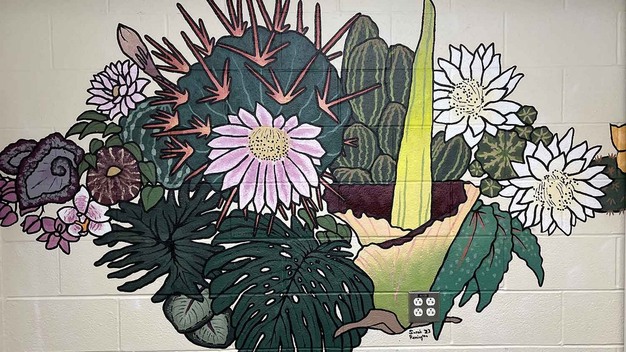Anyone who has experienced the glory of a Bob Ross Public Broadcasting Service (PBS) program knows you can quiet your mind, combat anxiety, and find a rare peace that only art can provide. However, in the past few years, interest in horticulture and horticulture therapy, both on and off campus, has increased, and people are using gardens, nurseries, and houseplants to combat mental and physical health issues.
A student in the Department of Horticultural Science brought together plants and paintbrushes to create a beautiful mural in the headhouse of the Marye Anne Fox Science Teaching Laboratory.

Junior Sarah Remington, the artist behind the mural, transferred into the major when the horticultural science siren’s song called her into its floral, plant-filled world. Like bees to flowers, many students are drawn to horticulture simply because there is peace and art to help a plant grow and thrive until it eventually produces a colorful result from its work.
While Remington’s love of plants is apparent, she started doing art when she was young.
“I was a big dragons and wizards kid, so I got my first art tutorial book at the Scholastic Book Fair… it was a How To Draw Dragons book.”
While art, class, and greenhouse work can take up a lot of time, Remington was also part of the group that helped visitors at the JC Raulston Arboretum when one of the Department of Horticultural Science’s corpse flowers recently bloomed. She said that places like arboretums or public gardens are great locations to see where art and horticulture can merge as we see softscapes (plants) mingle with hardscapes (statues, fountains, etc.) to create a unique environment.
Many areas, especially urban areas, are using functional greenscapes not only for their benefit to the environment — like trees to help clean the air and water, green roofs, or rain gardens — but they also provide an aesthetic that is pleasing and welcoming.
The crossroads of art and horticulture have no clear boundaries as people can do everything from drawing and painting, like Remington, or collecting leaves to press into collections or collages, designing landscapes on their property, drying flowers to preserve in resin or light boxes, and creating topiaries.
Remington says that blending the two worlds is beneficial because one can feed the other. When it comes to her art, she says, “Having access to plants and things like that gives me ideas [for my art].” It’s the quest of finding what works specifically for an individual that leads many to explore available campus resources so they, too, can find their best creative outlet and produce beauty for themselves and those around them.
Students in any major can take advantage of Flourish, one of the North Carolina State University’s Prevention Services drop-in spaces that focus on horticulture. Students not only can learn about horticulture from faculty and staff in the Department of Horticultural Science in a relaxed setting but there are also hands-on activities that let students move beyond a lecture-type environment and participate in the horticulture therapeutic process. Also, if plants are not your cup of tea, NC State’s Crafts Center invites you to check out and attend classes and programs for students called CRAFTernoons.
Staff and faculty also have options at the Crafts Center with multiple sessions called Break2MAKE. These sessions are intended to give employees the opportunity to wash away stress through programs like pottery, jewelry making, building with clay, working with powdered glass and metal, and more. The outlet of art, when combined with areas like horticulture, can bring endless benefits, many of which can be in the form of improved mental health. Each of us can do this differently, be it with horticulture, painting, walks in the woods, reading in a hammock on campus, or speaking to someone at the Counseling Center, but having resources on campus can help anyone in need. Having people like Remington share their creations also helps to remind us we can find beauty in so many places.
Source: cals.ncsu.edu
